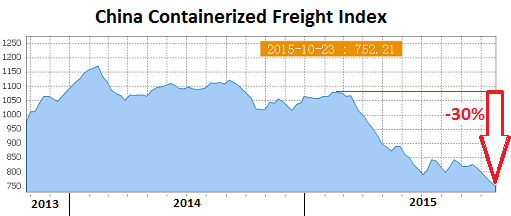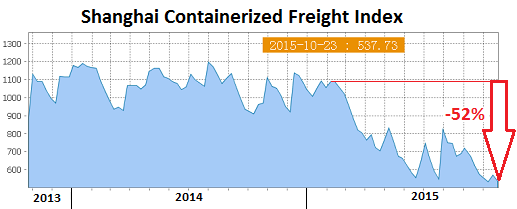Just when you thought it couldn’t get worse….
A week ago, we pointed out how China’s dropping exports and plunging imports – the “inevitable fallout from China’s unsustainable and poorly executed credit splurge,” according to Thomson Reuters – had collided with long-term bets by the shipping industry that has been counting on majestic endless growth.
The industry has been adding capacity in quantum leaps, where “the scramble to order so-called ultra-large container vessels had turned into a stampede,” as the Journal of Commerce put it. So we said, Pummeled by Lousy Global Demand and Rampant Overcapacity, China Containerized Freight Index Collapses to Worst Level Ever.
And now, the China Containerized Freight Index (CCFI) has dropped to an even worse level.
Unlike a lot of official data emerging from China, the index, which is operated by the Shanghai Shipping Exchange and sponsored by the Chinese Ministry of Communications, is raw, unvarnished, not seasonally adjusted, or otherwise beautified. It’s volatile and a reflection of reality, as measured by how much it costs, based on contractual and spot market rates, to ship containers from China to 14 major destinations around the world.
These rates are a function of oversupply of shipping capacity and of lackluster demand for shipping containers to distant corners of the world. They’ve been in trouble since February. “Trouble” is a euphemism. They relentlessly plunged.
By early July, the index dropped below 800 for the first time in its history, which started in 1998 when the index was set at 1,000. It soon recovered to about 850. And just when bouts of hope were rising that the worst was over, it plunged again and hit even lower levels.
The latest weekly reading dropped another 1.7% from the prior week to 752.21, the worst level ever. The CCFI is now 30% below where it had been in February this year and 25% below where it had been 17 years ago at its inception.
The Shanghai Containerized Freight Index (SCFI), also operated by the Shanghai Shipping Exchange, tracks spot rates (not contractual rates) of shipping containers from Shanghai to 15 major destinations around the world. It’s even more volatile than the CCFI. But being based on spot rates, it’s a good indicator where the CCFI is headed.
For last week, the SCFI plunged 5.4% to a new record low of 537.73, down 46% from where it had been at its inception in 2009 when it was set at 1,000 – and down 52% from February:
Not that any of this matters for stocks. What matters are central banks. And they have once again spoken. They’re frazzled by these signs of “unexpected” deterioration. Even China’s official GDP growth rate, at 6.9%, inflated as it may be, is now down to the worst level since the Financial Crisis.
So Friday morning, while perhaps still smarting from the Shanghai stock index’s plunge of 3.1% on Wednesday, the People’s Bank of China stepped in and announced that it would lower its benchmark interest rates by a quarter point, the sixth cut since November, and banks’ reserve-requirement ratios by half a point, all to flood the economy with even more money.
Whatever rounds of speculation this might trigger, it won’t stimulate global demand for Chinese goods and won’t help exports one iota. However, it goosed stocks worldwide on Friday. And that’s what matters.
Already on Thursday, it had been the European Central Bank that had done its magic in a magnificent spectacle of insinuation of its own. Read… Draghi Speaks, Euro Falls Off Chart, Stocks Soar Despite Layoffs, Shrinking Revenues, and Evil “Strong Dollar” that just Got a Heck of Lot Stronger
Enjoy reading WOLF STREET and want to support it? You can donate. I appreciate it immensely. Click on the mug to find out how:
![]()




“it goosed stocks worldwide on Friday. And that’s what matters.”
The Central Bankers of the World are making every effort to provide enough stimulus to bring the markets past the end of this years unfavorable period for stocks. They appear to believe that if only they can get these markets to November 1 without a significant correction all will be well.
We are always looking at various levels in the economic pyramid to judge its health.
Let’s have a look at its foundations, the global consumer:
1) The once wealthy Western consumer has had all their high paying jobs off-shored. As a stop gap solution they were allowed to carry on consuming through debt. They are now maxed out on debt.
2) Japanese consumers have been living in a stagnant economy for decades.
3) Chinese and Eastern consumers were always poorly paid and with nonexistent welfare states are always saving for a rainy day. Western demand slumped in 2008 and the debt fuelled stop gap has now come to an end.
4) The Middle Eastern consumers are now too busy fighting each other to think about consuming anything and are just concerned with saying alive.
5) South American and African consumers are busy struggling with economies that are disintegrating fast.
Oh dear.
Nice rundown. Production doesn’t mean anything if there’s no one to consume what’s produced.
Wages have been the mechanism for redistributing surplus from corporations to the consumer, stopped expanding in late 70s / early 80s.
We need a guaranteed Basic Income, for this and so many more reasons. See this lecture:
https://www.youtube.com/watch?v=tE04_s9Bd5Q
A consumer that is not a nett producer himself is a nett drain on the economy.
Interesting video, I have heard of the idea before but it went into more detail.
We have the technology and production capacity for it to work.
Many years ago (1970s/1980s) people thought technology would mean everyone worked less and its benefits would be spread out.
But the few have kept the benefits and for the majority things have got worse.
With technology becoming more advanced, then the decline in purchasing power of the majority may force this change to maintain demand in the economy.
I can imagine the powers that be will let things get pretty bad before they change their ways but when lack of demand starts affecting them they will be looking for a solution.
This actually could be much sooner than anyone expects looking at the state of the global economy.
As I previously posted, the lack of inventory can be seen in the department stores. They have a little of most things but not a lot of anything. I figured maybe they are selling more online. Having seen holiday items out, including Xmas, at my local discount store, I thought the mall would be in holiday mode too. But it wasn’t.
Many years ago there was a sort of frenzy in all parts of the economy for the so called Toyota Production System (TPS). Self-proclaimed experts in this system assured your firm could become as efficient as Toyota if you just wrote them a big enough check.
As a friend of mine (Rolls-Royce engineer) commented “They aren’t telling half the story. If you were Toyota would you give your secrets to the competition?”.
Regardless, part of the TPS was the kanban system, which pretty much revolves around having the bare minimum stock of parts, goods etc in-house and continuously replenishing it according to need instead of simply keeping large stocks.
Now: kanban is exceedingly difficult to get right because you invariably end up with either far too much stock or, more often, not enough of what you need.
What we are seeing in the shops is what happens when kanban breaks down. Shops are keeping the absolute bare minimum of stocks but, differently from Toyota real-world practice, they haven’t a so-called “buffer stock” which allows one to deal with all those inconvenients that happen in the real world (a strike at a logistic center, a lorry breaking down on the road, unseen peak demand etc).
This leads to seeing more and more often to empty aisles, as I am seeing in some local supermarkets.
Coupled to this is the whole sorry saga of delaying payments to vendors as long as possible. Small vendors just need the business and hence are easily convinced/cajoled/threatened to deliver more stock on credit, but large ones aren’t so easily bullied. They won’t think twice about stopping shipments until the payment clears.
Oh come on, this stat has merely shown that China has made a successful transition to a 100% service based economy. And so has the rest of the world. :)
Careful, you might get appointed as a Professor of economics.
Indeed.
Live to Serve, Serve to Live. Die poor.
The “Knock on Effect”.
The global CAPEX boom is now dead. Asset accumulation and inflation has switched to asset liquidation and deflation.
There is a severe lack of liquidity in the markets. Asset valuations are much too high and are leading to forced liquidation to cover, which will bring valuations down. The knock on effect.
When overcapacity meets sluggish or declining demand, all kinds of economic activities begin to stumble. The energy (oil) sector being just the precursor, acting as the canary in the mine.
It is unnecessary for corporatists, especially banksters, to invest in any actual productive assets, not when they can simply have the government print up money, give it to them to stash in tax havens, and bill the general population for it. Why have an economy at all? So far as the rich are concerned, there’s no need for it.
As long as central banks can control the money supply they will be able to manipulate stocks higher.
‘Money neutrality’: m1/p1 = m2/p2.
By QE they’re determined to make sure ‘m’ is always increasing which means asset prices ‘p’ will be taken in tow. This is the inflation those like Krugman deny.
So? Do we NEED toxic things made in China? Might we even [GASP] make things ourselves?? Who cares if the markets crash. They’re rigged. Let ’em crash. Then we can rebuild a new system that doesn’t put 300 million people $100 trillion in debt to work!
if you want to breathe air like this then bring the factories home
http://www.marketplace.org/sites/default/files/beijing-smog.jpg